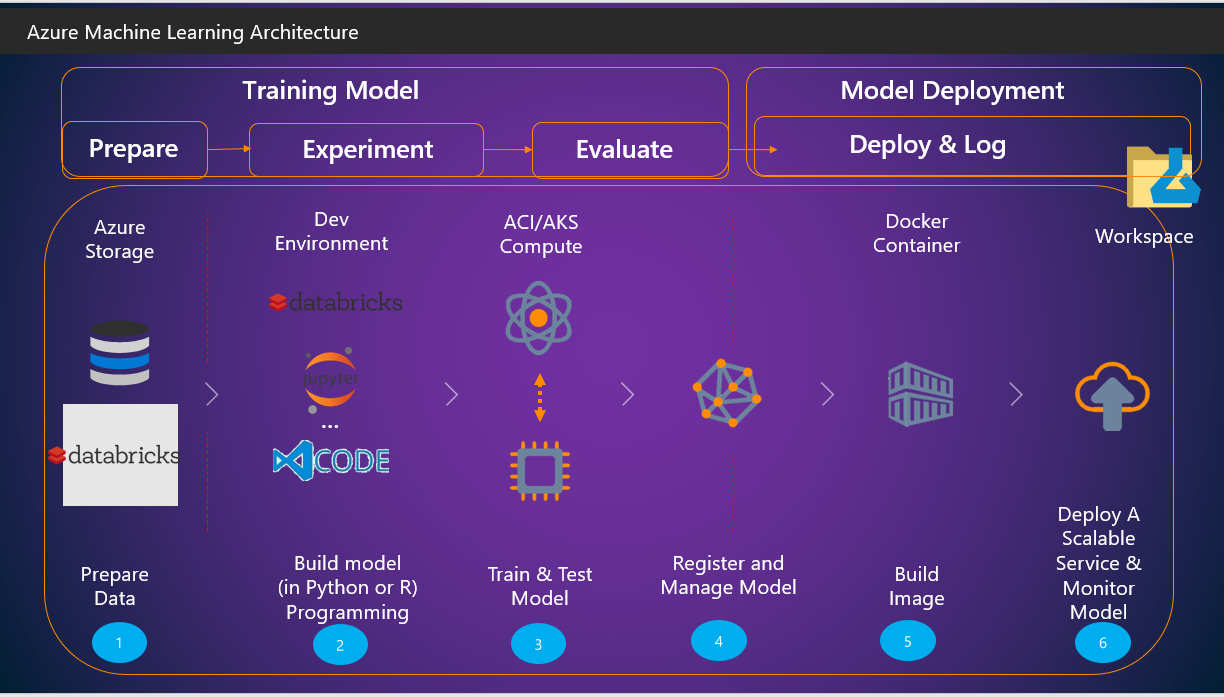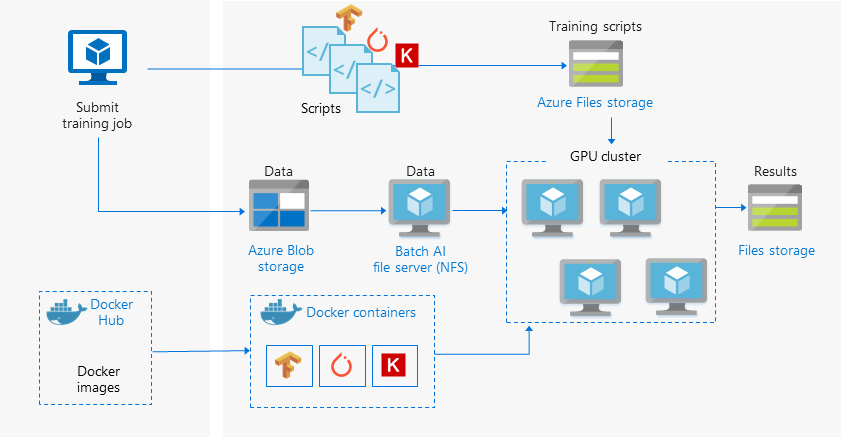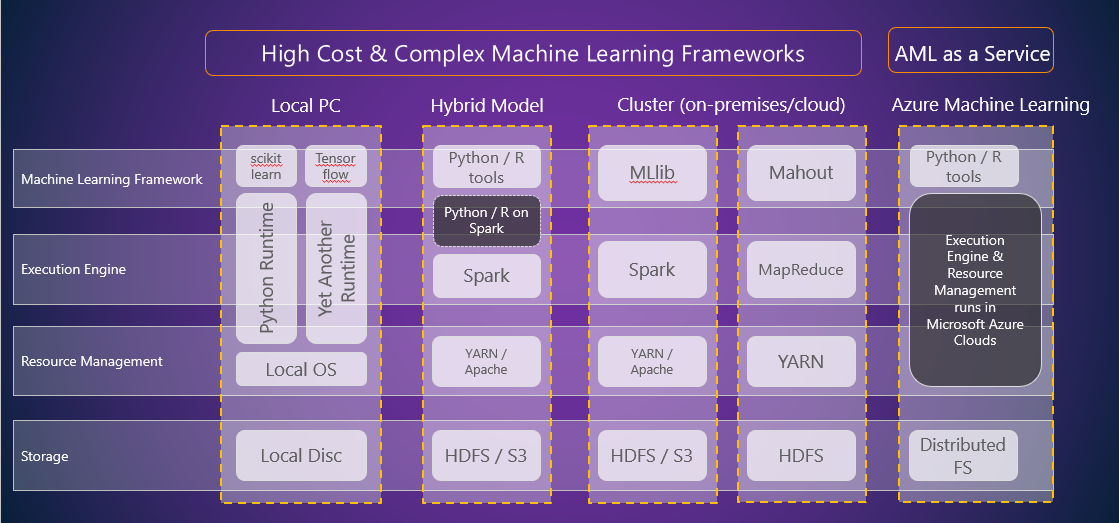Azure Machine Learning Service: Business Benefits
Objective
This post explains about the business benefits using Azure Machine Learning Service to develop & productionize the smarter AI solutions to complex data science problems.
Introduction
Azure Machine Learning cloud service is used to enhance the productivity of data scientists with guided execution of entire machine learning life cycle that includes
- Systematic Data preparation for training the models for accuracy of the prediction.
- Cost effective Deployment of the trained models for as the webservice API.
- Automation and management of machine learning models, all at the broad scale.
- Tracking the execution of the models for better understanding of it’s performance.
Targeted Audience
Decision makers, Decision Influencers, AI/Automation/Big Data Architects/Data Scientists
Overview of Azure Machine Learning Service Architecture
Following diagram describes about how Azure Machine Learning Framework can be used to ease the complex, protracted & expensive Data science process in a systematic way to deliver the quality AI solutions . This is the msdn reference to the detail overview of Azure Machine Learning Service.
Azure Machine Learning life cycle is broadly divided into Training & Deployment Phase. Also this architecture diagram details about the 6 steps involved in each of these phases with key concepts.
Figure 1: Detailed Azure Machine learning Life Cycle
Please find the details of steps described in the image above in this MSDN reference.
Key Concepts
Key concepts (depicted in above architecture diagrams ) is described as below.
Workspace: Workspace is the Azure offering to keep all the machine learning artifacts at the central place,where data scientists can track the end to end flow(s) of Model execution.This is for logical organisation of Experiments, Models, Images & Computes.
Model: This is the output of the machine learning algorithm that helps to find the required prediction based on the past history datasets.
Experiment:This is Azure Machine Learning Object to track the execution of Models.
Images : This is Deployment Package Object representing the Model.
How to use Azure Machine Learning Service?
1) Pre-Configured Machine Learning Environments to save Project Cost
Problem Statement:
In traditional Machine Learning Projects, To get started with the any new framework or tool’s setup in the manual way, adds to the efforts & cost of such projects.
Solution:
- Azure Machine Learning Service can be easily configured (setup) in the Data science Virtual Machine with which Data Scientists/ML community can quickly start building and deploying models, thereby providing cost and effort saving to such projects.
- To train & build the model, the pre-configured Data science VM is instrumental with all the required Machine Learning tools & frameworks (as shown in the image below) for Windows & Linux Platforms. Alternatively Microsoft Azure notebooks plays the important roles in sandbox execution of the model for dev/test scenarios & finding out model for accurate prediction.
Figure 2: Environments for Azure Machine Learning (Reference:Data science Virtual Machine)
- With no down time, training Jobs can also be executed on local machine (with minimal installation) and then scale up and out using the Azure cloud as described above.
2) Centralized Machine Learning Workspace
Problem Statement:
In traditional machine learning project, It is needed to dive into different directions and if something fails,then it is not easy to track problems. Find more details about using Machine Learning Workspace here .
Solution:
Figure 3: Machine Learning Workspace Components (Reference : Machine Learning Workspace)
New Azure machine learning service,provides the logical workspace.
- To find all artifacts related to execution of deployed model at one centralized place.
- To visualize the multiple executions of same model or multiple models in parallel
- To get the better insights about ‘How to train & deploy’ more effectively.
- To monitor the failures during the execution and track the logs & matrices.
3) Automated machine learning
This is one of the greatest Azure Machine learning feature. With Automated machine learning , without having to manually identify best algorithm & relevant features (dataset columns that represents hyperparameters) to get accurate prediction, Machine learning model itself determines prediction automatically with the help of statistical measures.
This diagram shows the typical machine learning life cycle.
Figure 4: Typical Machine Learning Flow (Reference: Automated machine learning)
Here Feature engineering is process of identifying best the metadata (input columns) that impacts the predictions value tremendously.Model Training & **Evaluation **is the process where machine learning algorithms are used to get predictions based on metadata obtained in Feature Engineering.
Find more details about Automated machine learning here
Problem Statement:
Data scientist needs to manually perform steps (shown in the above image) that has impact on cost & productivity.
Solution:
This Automated Machine Learning (as described in the image below) feature helps business.
- To democratize the scope of AI for the bigger numbers of audience like business domain experts (Open AI concept).
- To build the high quality predictive models.
- To be business focused to solve complex problems rather than spending manual efforts on statistical or mathematical calculations , data cleaning & pre-processing .
- To save the cost with **Auto scaling **that enables auto-shutdown of compute when training job is over.
- To drive the business decisions, through simplified and worthwhile visual graphs.
4) Business Centric Machine Learning Pipelines
Machine learning Pipeline is the templetize workflow of data science steps such as training and model deployment that can be triggered as the REST endpoint from front end application.
Figure 5: Machine Learning Pipeline (Reference : Machine Learning Pipeline)
Problem statements:
- Execution of the business logic in data science steps (shown in the image above),may become unmanageable without having appropriate CI/CD (Continuous Integration/Deployment mechanism in place.
- Inefficient use of compute options to run the data science steps, is the costly operation.
Solution:
Machine Learning Pipeline helps business
- To Focus on Business problem rather than infrastructure.
- To optimize workflow with simplicity, speed, portability, and reuse (this helps data scientists to focus on Business problem rather than infrastructure).
- With efficient use of different compute options,Machine Learning Pipelines can be executed on mixed on diverse computes .
- Appropriate Tracking & Versioning and CI/CD mechanism results into great productivity.
Find more about Machine Learning Pipeline here
5) Cost Effective Deep Learning Methodologies
Deep Learning is a specification of machine learning for image classification and object detection in images or video etc. It is inspired by the structure and function of the human brain cells called neural networks.
Problem Statement:
In traditional deep learning methods, there has been always the challenge of processing (training) huge Image datasets,that may need weeks & months to complete before it actually goes through machine learning life cycle.
Solution:
Below architecture diagram describes about scaling up the deployment of deep learning solutions with distributed training in Azure machine learning service.
Figure 6 : Distributed Training of Deep Learning Model (Reference : Distributed Training )
Find more details about this Distributed Training architecture.
Azure Machine Learning offers tremendous benefits over traditional deep learning methodologies,such as
- This Azure AI Offering with built-in capabilities of Pytorch(Open Machine Leaning Framework), Microsoft Cognitive Toolkit, Tensorflow, Caffe, yields significant reduction in training time and increased productivity.
- Customers can productionize their projects at scale without being stuck at specific tools or platforms.
6) Azure Machine Learning as a Service
Problem Statement:
In traditional machine learning, it is needed to consider big project cost while building the machine learning projects.
Solution:
This architecture diagram below , clarifies the comparisons details about complexity & cost of machine learning infrastructure in traditional machine learning frameworks vs Azure Machine learning.
Real World Business Cases using Azure Machine Learning Service
Here is the brief description about how Microsoft customers use Azure Machine Learning Service for to solve real world problems with improved productivity. (Here is the list of few of them.) . Find more customer stories here.
Intelligent Retinal Imaging System
This Healthcare customer has leveraged Azure Machine Learning with NVDA GPU (Compute) for Deep learning Analysis of Retina (Front layer on Eye) Images.
Diabetic patients can be suffered from diabetic retinopathy that leads to loss of vision.
Business Benefit
This analysis predicts the Diabetic patients who can be potentially become blind & the stage at which preventive measures should be taken to avoid the the blindness. Around 1 million patients are benefited using this theory.
Mercedes Benz
This Automotive Customer has revolutionized the sales process with Azure Machine Learning for targeting their clients across 180 service locations across the world.
Business Benefit:
With predictive analysis on datasets, that contains the information such as Legislation info, macroeconomic indicators and sales information and statistics in each region of the country, gives increasingly intelligent insights.
With these insights, at every monthend, dealers reports the offer which is more relevant to their customers & that is converted to successful deals.
Bing Ads
This Digital customer,leverage Azure machine learning to generate the Bing advertisements that are more likely to be clicked or viewed.
Business Benefit:
This in turn results in identification of spending projections to get more accurate results & high revenue generation.
Schneider Electric
This Oil & Gas industry customer has migrated edge solutions into new, predictive realms with the help of Azure Machine Learning and Azure IoT Edge.
Business Benefit:
Using Machine Learning gives IoT devices the ability to analyze readings from various elements and identify the patterns that indicate a possible impending mechanical failure.
With this predictive maintenance, IoT device can modify the parameters & prevent the impact of unexpected change.
(Note: Images & Links are included for quick overview with reference links.. This gives the audience a big picture of Azure Machine Learning Service)






